dissertation in pdf-format - Aalto-yliopisto
dissertation in pdf-format - Aalto-yliopisto
dissertation in pdf-format - Aalto-yliopisto
Create successful ePaper yourself
Turn your PDF publications into a flip-book with our unique Google optimized e-Paper software.
45<br />
3 Research methodology<br />
In one of the few studies on the topic of validity or quality criteria <strong>in</strong><br />
mixed research, Teddlie and Tashakkori (2003) po<strong>in</strong>ted out that <strong>in</strong>ferences<br />
are made whether the associated <strong>in</strong>terpretation is deductive or <strong>in</strong>ductive <strong>in</strong><br />
nature. These authors contended that the concept of <strong>in</strong>ference transcends<br />
quantitative and qualitative research and they recommended that<br />
<strong>in</strong>terference quality should be used as the term for validity <strong>in</strong> mixed<br />
research. They conceptualize <strong>in</strong>ference quality as be<strong>in</strong>g associated with two<br />
research components: design quality and <strong>in</strong>terpretative rigour. Accord<strong>in</strong>g to<br />
their <strong>in</strong>tegrative model of <strong>in</strong>ference quality, design quality comprises:<br />
1. With<strong>in</strong>-design consistency<br />
2. Design suitability<br />
3. Design fidelity<br />
4. Analytic adequacy<br />
With<strong>in</strong>-design consistency refers to standards used for evaluat<strong>in</strong>g the<br />
methodological rigour of mixed method studies. Design suitability refers to<br />
whether the methods used are appropriate for address<strong>in</strong>g the research<br />
question(s) and the design is consistent with them. Design fidelity refers to<br />
whether procedures: are implemented with rigour and quality; are capable<br />
of captur<strong>in</strong>g mean<strong>in</strong>g, associations and/or effects; and the sampl<strong>in</strong>g and<br />
data collection procedures are implemented adequately. Analytic adequacy<br />
refers to the appropriateness of applied data analysis techniques for<br />
address<strong>in</strong>g the research question(s) (Tashakkori and Teddlie, 2006).<br />
Interpretive rigour perta<strong>in</strong>s to the overall standards for evaluat<strong>in</strong>g the<br />
validity of conclusions of the study. It consists of <strong>in</strong>terpretative agreement,<br />
dist<strong>in</strong>ctiveness, <strong>in</strong>terpretative consistency and theoretical consistency.<br />
Interpretative agreement means that people agree about <strong>in</strong>terpretations,<br />
i.e. there is consistency of <strong>in</strong>terpretations across people. Interpretative<br />
dist<strong>in</strong>ctiveness is the degree to which the <strong>in</strong>ferences are dist<strong>in</strong>ctively<br />
different from other possible <strong>in</strong>terpretations of the results, and rival<br />
explanations are ruled out. Interpretive and theoretical consistencies are<br />
connected to the <strong>in</strong>ferences that closely follow from relevant f<strong>in</strong>d<strong>in</strong>gs <strong>in</strong><br />
terms of type, <strong>in</strong>tensity, scope, and multiplicity. Interpretive consistency<br />
refers to whether the <strong>in</strong>ferences are consistent with each other, and<br />
theoretical consistency to whether the <strong>in</strong>ferences are consistent with theory<br />
and current knowledge <strong>in</strong> the field, and whether meta-<strong>in</strong>ferences<br />
adequately <strong>in</strong>corporate the <strong>in</strong>ferences from quantitative and qualitative<br />
phases of the study (Tashakkori and Teddlie, 2006).<br />
Onwuegbuzie and Johnson (2006) extended the model proposed by<br />
Tashakkori and Teddlie (2006) of the validity of mixed methods. They
















